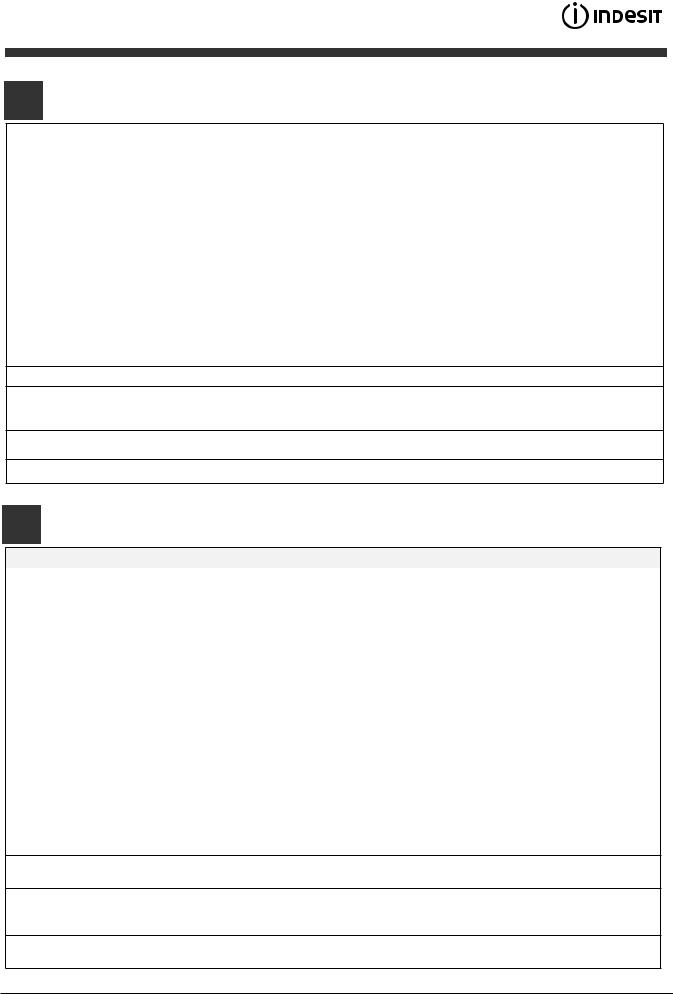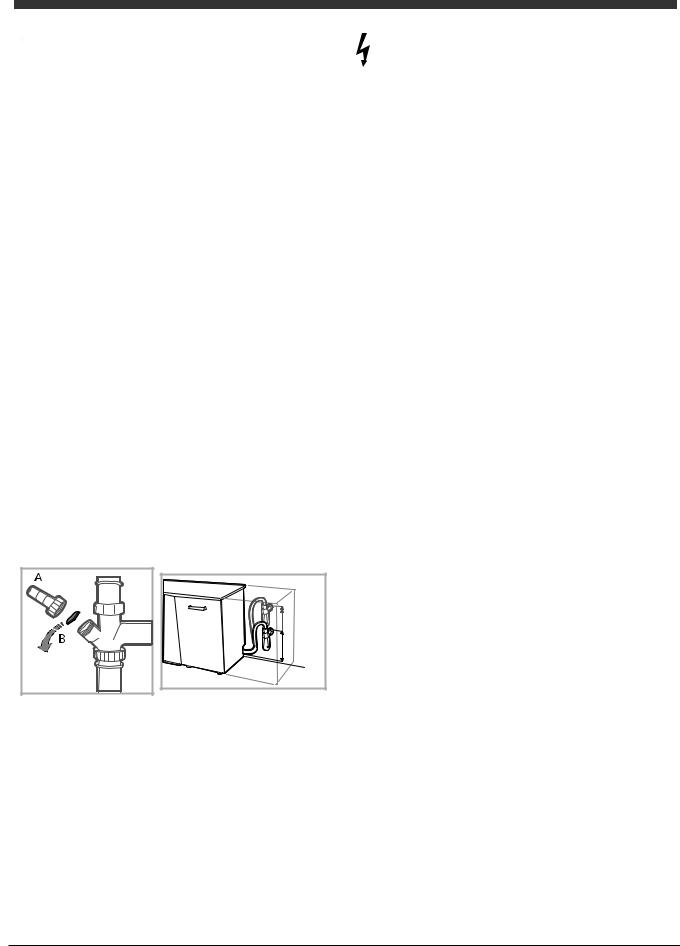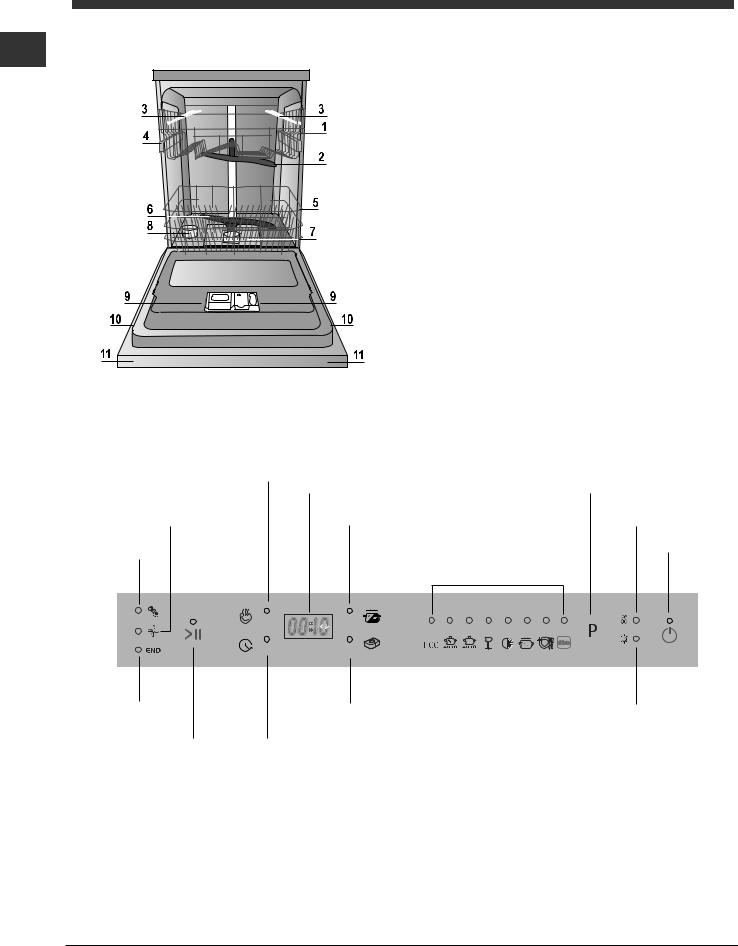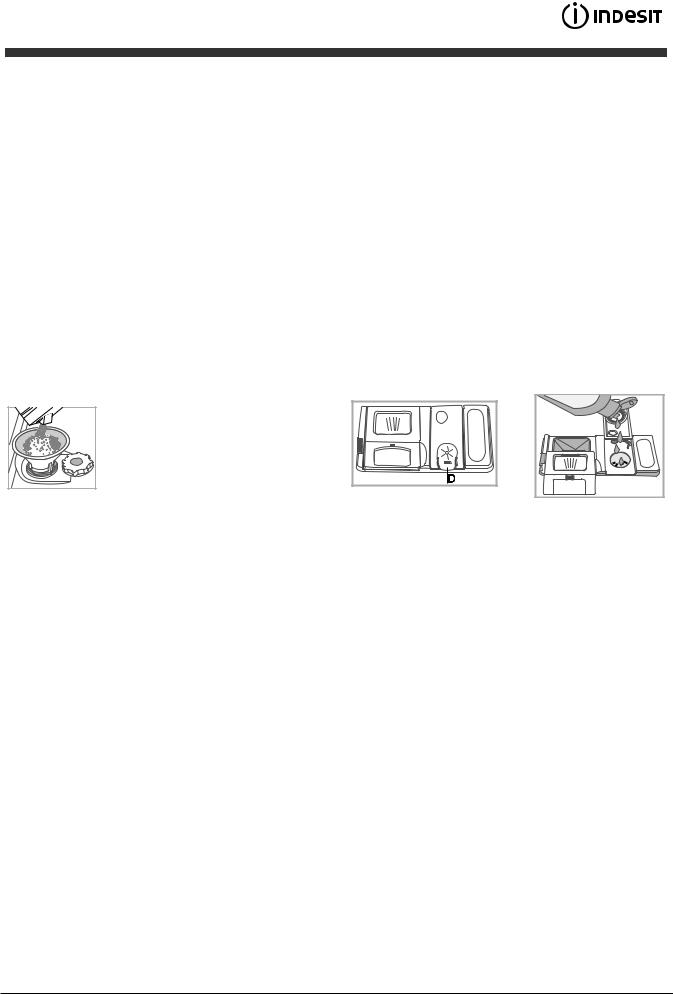Indesit DPP 48T9 A NX EU User Manual [de]

DPP 48T9
EN English
Operating instructions
DISHWASHER - Contents
Operating instructions, 1
Precautions and advice, 2-3
Assistance, 4
Product Data, 5
Installation, 6-7
Description of the appliance, 8
Refined salt and rinse aid, 9
Loading the racks, 10-11
Detergent and dishwasher use, 12
Wash cycles, 13
Special wash cycles and options, 14
Care and maintenance, 15
Troubleshooting, 16
DE Deutsch
Gebrauchsanleitung
GESCHIRRSPÜLER – Inhaltsverzeichnis
Gebrauchsanleitung, 1 Vorsichtsmaßnahmen und Hinweise, 3-4 Kundendienst, 4
Produktdatenblatt, 5 Installation, 17-18
Beschreibung Ihres Geschirrspülers, 19 Regeneriersalz und Klarspüler, 20 Beladen der Körbe, 21-22
Spülmittel und Verwendung des Geschirrspülers, 23 Programme, 24
Sonderprogramme und Optionen, 25 Reinigung und Pflege, 26 Störungen und Abhilfe, 27
1

EN Precautions and advice
 This appliance was designed and manufacturedincompliancewithinternational safety standards. The following information has been provided for safety reasons and should be read carefully.
This appliance was designed and manufacturedincompliancewithinternational safety standards. The following information has been provided for safety reasons and should be read carefully.
Keep this instruction manual in a safe place for future reference. If the appliance is sold, given away or moved, make sure the manual is kept with the machine.
Read the instructions carefully, as they include important information on safe installation, use and maintenance.
This appliance was designed for domestic use or similar applications, for example:
- farmhouses;
- use by guests in hotels, motels and other residential settings;
- bed & breakfasts.
Remove the appliance from all packaging and make sure it was not damaged during transportation. If it was damaged, contact the retailer and do not proceed any further with the installation process.
General safety
• This appliance should not be operated by children younger than 8 years, people with reduced physical, sensory or mental capacities, or inexperienced people who are not familiar with the product, unless they are given close supervision or instructions on how to use it safely and are made aware by a responsible person of the dangers its use might entail.
• Children must not play with the appliance.
• It is the user's responsibility to clean and maintain the appliance. Children should never clean or maintain it unless they are given supervision.
• The appliance was designed for domestic use inside the home and is not intended for commercial or industrial use.
• The appliance must be used to wash domestic crockery in accordance with the instructions in this manual.
• The appliance must not be installed outdoors, even in covered areas. It is extremely dangerous to leave the machine exposed to rain and storms.
• Do not touch the appliance when barefoot.
• When unplugging the appliance always pull the plug from the mains socket. Do not
pull on the cable.
• The water supply tap must be shut off and the plug should be removed from the electrical socket at the end of every cycle and before cleaning the appliance or carrying out any maintenance work.
• The maximum number of place settings is shown in the product sheet.
• If the appliance breaks down, do not under any circumstances touch the internal parts in an attempt to perform the repair work yourself.
• Do not lean or sit on the open door: this may cause the appliance to overturn.
• The door should not be left open as it may create a dangerous obstacle.
• Keep detergent and rinse aid out of reach of children.
• The packaging material should not be used
as a toy.
• Knives and other utensils with sharp edges must be placed either with the points/blades facing downwards in the cutlery basket or horizontally on the tip-up compartments or in the tray/third basket, if available.
• Connect the appliance to the water mains using the new supply hose provided with the appliance. Do not re-use the old hose.
• Install the back side of a free-standing dishwasher against a wall.
Disposal
• To dispose of any packaging materials, follow local legislation so that the packagings may be reused.
• The European Directive 2012/19/EU relating to Waste Electrical and Electronic Equipment (WEEE) states that household appliances should not be disposed of using the normal solid urban waste cycle.
Exhausted appliances should be collected separately in order to optimise the cost of reusing and recycling the materials inside the machine, while preventing potential damage to the atmosphere and public health. The crossed-out dustbin symbol shown on all products reminds the owners of their obligations regarding separated waste collection.
For further information relating to the correct disposal of household appliances, owners may contact the relevant public authority or the local appliance dealer.
2

Saving energy and respecting the environment
Saving water and energy
• Only begin a wash cycle when the dishwasher is full. While waiting for the dishwasher to be filled, prevent unpleasant odours with the Soak cycle (if available, see
Wash Cycles).
• Select a wash cycle that is suited to the type of crockery and to the soil level using the Table of Wash Cycles:
- For dishes with a normal soil level, use the Eco wash cycle, which guarantees low energy and water consumption levels.
- If the load is smaller than usual activate
the Half Load option (see Special wash cycles
and options, if available).
• If your electricity supply contract gives details of electricity-saving time bands, run the wash cycles when electricity prices are lower. The Delayed Start option can help you organise the wash cycles accordingly
(see Special wash cycles and options, if available).
DE VorsichtsmaßnahmenHinweise und
 Das Gerät wurde nach den strengsten internationalen Sicherheitsvorschriften konzipiert und hergestellt. Nachstehende Hinweise werden aus Sicherheitsgründen angegeben und sollten aufmerksam gelesen werden.
Das Gerät wurde nach den strengsten internationalen Sicherheitsvorschriften konzipiert und hergestellt. Nachstehende Hinweise werden aus Sicherheitsgründen angegeben und sollten aufmerksam gelesen werden.
Bewahren Sie diese Bedienungsanleitung sorgfältig auf, damit Sie sie jederzeit zu Rate ziehen können. Im Falle eines Verkaufs, einer
Übergabe oder eines Umzugs muss sie dem
Gerät stets beiliegen.
LesenSiediefolgendenHinweiseaufmerksam durch, denn sie liefern wichtige Informationen hinsichtlich der Installation, des Gebrauchs und der Sicherheit.
Dieses Gerät wurde für den Hausgebrauch oder ähnliche Anwendungen konzipiert, zum Beispiel:
- Bauernhäuser
- Nutzung durch Kunden in Hotels, Motels und anderen Wohnbereichen
- Frühstückspensionen
Nehmen Sie das Verpackungsmaterial ab und prüfen Sie Ihr Gerät auf eventuelle Transportschäden. Schließen Sie das Gerät im Falle einer Beschädigung bitte nicht an, sondern fordern Sie den Kundendienst an.
Allgemeine Sicherheit
• Dieses Haushaltsgerät darf von Kindern ab acht Jahren und von Personen mit eingeschränkten körperlichen, s e n s o r i s c h e n o d e r g e i s t i g e n
Fähigkeiten oder ohne Erfahrung und der notwendigen Kenntnis verwendet werden, vorausgesetzt, sie werden streng von einer verantwortungsbewussten Person überwacht oder sie haben eine ausreichende Einweisung in die sichere
Nutzung des Geräts erhalten und die damit verbundenen Gefahren verstanden.
• Kinder dürfen nicht mit dem Gerät spielen.
• Die Reinigung und die Wartung des
Geräts müssen vom Benutzer ausgeführt werden. Diese Arbeiten dürfen nicht von unbeaufsichtigten Kindern ausgeführt werden.
• DiesesGerätistfürdennichtprofessionellen
Einsatz in privaten Haushalten bestimmt.
• Das Gerät darf nur zum Spülen von
Haushaltsgeschirr und gemäß den Anleitungen dieses Handbuchs verwendet werden.
• Das Gerät darf nicht im Freien aufgestellt werden, auch nicht, wenn es sich um einen geschützten Platz handelt. Es ist äußerst gefährlich, das Gerät Regen und Gewittern auszusetzen.
• Berühren Sie den Geschirrspüler nicht, wenn Sie barfuß sind.
• Ziehen Sie den Netzstecker nicht am
Netzkabel aus der Steckdose, sondern nur am Netzstecker selbst.
• Vor Reinigungsund Wartungsarbeiten mussamEndejedesZyklusderWasserhahn zugedreht und der Netzstecker aus der Steckdose gezogen werden.
• Die höchstzulässige Anzahl an Gedecken ist auf dem Produktdatenblatt angegeben.
• Versuchen Sie bei etwaigen Störungen keinesfalls, Innenteile selbst zu reparieren.
• Stützen Sie sich und setzen Sie sich nicht auf die offen stehende Gerätetür; das Gerät könnte umkippen.
• Die Gerätetür sollte nicht offen gelassen werden, da man darüber stolpern könnte.
• Bewahren Sie das Spülmittel und den
Klarspüler außerhalb der Reichweite von Kindern auf.
• Verpackungsmaterial ist kein Spielzeug für
Kinder.
• Messer und anderes Besteck mit scharfen
Kanten müssen mit der Spitze/Klinge nach unten in den Besteckkorb gegeben oder horizontal auf die Klappfächer oder auf das
3

Tablett/den dritten Korb gelegt werden, sofern dies bei Ihrem Modell vorhanden ist.
• Das Gerät wird mit dem neuen
Versorgungsschlauch an das Wassernetz angeschlossen und der alte Schlauch darf nicht mehr verwendet werden.
• Handelt es sich bei der Spülmaschine um ein frei stehendes Gerät, muss die Rückseite an eine Wand gestellt werden.
Entsorgung
• Befolgen Sie die lokalen Vorschriften; Verpackungsmaterial kann wiederverwertet werden.
• Die europäische Richtlinie 2012/19/EG über Elektround Elektronik-Altgeräte (WEEE) sieht vor, dass Haushaltsgeräte nicht mit dem normalen Hausmüll entsorgt werden dürfen. Die Altgeräte müssen getrennt gesammelt werden, um die Rückführung und das Recycling der Materialen zu optimieren, aus denen die Geräte hergestellt sind, und um mögliche Belastungen der Gesundheit und der Umwelt zu verhindern. Das
Mülleimersymbol ist auf allen Produkten dargestellt, um an die Verpflichtung zur getrennten Abfallsammlung zu erinnern.
Für weitere Informationen hinsichtlich der ordnungsgemäßen Entsorgung von
Haushaltsgeräten wenden Sie sich bitte an Ihren Händler oder an die zuständige kommunale Stelle.
Energie sparen und Umwelt schonen
Wasser und Strom sparen
• Setzen Sie den Geschirrspüler nur bei voller
Ladung in Betrieb. Um in der Zwischenzeit, d. h. bis das Gerät ganz gefüllt ist, die Bildung unangenehmer Gerüche zu vermeiden, setzen Sie den Einweichzyklus
in Gang (sofern verfügbar – siehe Spülprogramme).
• Wählen Sie ein für das zu spülende Geschirr und den Verschmutzungsgrad geeignetes Programm. Ziehen Sie hierzu die Programmtabelle zu Rate:
- Verwenden Sie für normal verschmutztes Geschirr das umweltfreundliche
Sparprogramm Eco, das einen niedrigen
Wasser-undStromverbrauchgewährleistet. - Aktivieren Sie bei geringfügiger Beschickung die Option Halbe Füllung
(sofern verfügbar – siehe Sonderprogramme und
Optionen).
• Sieht Ihr Stromliefervertrag Billigstromzeiten vor, empfiehlt sich, das Gerät in diesen
Zeiten in Betrieb zu setzen. Die Option
Verzögerter Start kann dabei helfen, die Spülgänge entsprechend zu organisieren
(sofern verfügbar – siehe Sonderprogramme und Optionen).
EN Assistance
Before contacting Assistance:
•Check whether the problem can be resolved using the
Troubleshooting guide (see Troubleshooting).
•Restart the programme to check whether the problem has ceased to exist.
•If the problem persists, contact the Authorised Technical
Assistance Service.
 Never use the services of unauthorised technicians. Please have the following information to hand:
Never use the services of unauthorised technicians. Please have the following information to hand:
•The type of malfunction.
•The appliance model (Mod.).
•The serial number (S/N).
This information can be found on the appliance data plate
(see Description of the appliance).
DE Kundendienst
Bevor Sie den Kundendienst anfordern:
•sollten einige Kontrollen vorab selbst durchgeführt werden (siehe Störungen und Abhilfe).
•Starten Sie das Programm erneut, um sicherzustellen, dass die Störung behoben wurde.
•Ist dies nicht der Fall, wenden Sie sich bitte an den autorisierten Kundendienst.
 Beauftragen Sie bitte niemals unbefugtes Personal. Geben Sie bitte Folgendes an:
Beauftragen Sie bitte niemals unbefugtes Personal. Geben Sie bitte Folgendes an:
•die Art der Störung
•das Gerätemodell (Mod.)
•die Seriennummer (S/N).
Diese Informationen können Sie auf dem am Gerät befindlichen Typenschild ablesen (siehe Beschreibung Ihres Geschirrspülers).
4

EN Product Data (product fiche)
Product Fiche |
|
Brand |
INDESIT |
Model |
DPP 48T9 |
Rated capacity in standard place settings (1) |
14 |
Energy efficiency class on a scale from A+++ (low consumption) to D (high consumption) |
A++ |
Energy consumption per year in kWh (2) |
265 |
Energy consumption of the standard cleaning cycle in kWh |
0.93 |
Power consumption of the off-mode in W |
0.5 |
Power consumption of the left-on mode in W |
5.0 |
Water consumption per year in litres (3) |
2520 |
Drying efficacy class on a scale from G (low efficacy) to A (high efficacy) |
A |
Programme time for standard cleaning cycle in minutes |
190 |
The duration of the left-on mode in minutes |
12 |
Noise in dB(A) Re 1pW |
44 |
Built-in model |
Yes |
NOTES
1) The information on the label and fiche relates to the standard cleaning cycle, this programme is suitable to clean normally soiled tableware and it is the most efficient programme in terms of combined energy and water consumption. The standard cleaning cycle corresponds to the Eco cycle.
2) Based on 280 standard cleaning cycles using cold water fill and the consumption of the low power modes. Actual energy consumption depends on how the appliance is used.
3) Based on 280 standard cleaning cycles. Actual water consumption depends on how the appliance is used.
DE Datenblatt
Datenblatt
Marke |
INDESIT |
Modell |
DPP 48T9 |
Nennkapazität in Standardgedecken für den Standardreinigungszyklus (1) |
14 |
Energieeffizienzklasse (A+++ niedriger Verbrauch) bis D (hoher Verbrauch) |
A++ |
|
|
Energieverbrauch pro Jahr in kWh (2) |
265 |
Energieverbrauch Standardreinigungszyklus in kWh |
0.93 |
Gewichtete Leistungsaufnahme im Aus-Zustand in W |
0.5 |
|
|
Gewichtete Leistungsaufnahme im unausgeschalteten Zustand in W |
5.0 |
|
|
Wasserverbrauch pro Jahr in Liter (3) |
2520 |
|
|
Trocknungseffizienzklasse (A höchste Effizienz) bis G (geringste Effizienz) |
A |
Programmdauer des Standardreinigungszyklus in Minuten |
190 |
Dauer des unausgeschalteten Zustands nach Programmende |
12 |
Luftschallemissionen dB(A) re 1pW |
44 |
Einbaugerät |
Ja |
HINWEIS |
|
1) Angabe auf Grundlage von 280 Standardreingungszyklen bei Kaltwasserbefüllung und dem Verbrauch der Betriebsarten mit geringer Leistungsaufnahme. Der tatsächliche Energieverbrauch hängt von der Art der Nutzung des Geräts ab.
2) Die Angaben beziehen sich auf den Standardreinigungszyklus. Dieses Programm eignet sich zur Reingung von normal verschmutztem Geschirr und ist am effizientesten in Bezug auf den kombinierten Energieund Wasserverbrauch. Der
Standardreingungszyklus entspricht dem Eco Zyklus.
3) Angabe auf Grundlage von 280 Standardreingungszyklen. Der tatsächliche Energieverbrauch hängt von der Art der Nutzung des
Geräts ab.
5

Installation
EN |
|
|
If the appliance must be moved at any time, keep it in an |
|
|
||
|
upright position; if absolutely necessary, it may be tilted onto |
||
|
|
||
|
|
its back. |
|
Connecting the water supply
 Adaptation of the water supply for installation should only be performed by a qualified technician.
Adaptation of the water supply for installation should only be performed by a qualified technician.
The water inlet and outlet hoses may be positioned towards the right or the left in order to achieve the best possible installation.
Make sure the dishwasher does not bend or squash the hoses.
Connecting the water inlet hose
•To a 3/4” gas cold or hot water connection point (max. 60°C).
•Run the water until it is perfectly clear.
•Screw the inlet hose tightly into position and turn off the tap.
 If the inlet hose is not long enough, contact a specialist store or an authorised technician (see Assistance).
If the inlet hose is not long enough, contact a specialist store or an authorised technician (see Assistance).
 The water pressure must be within the values indicated in the Technical Data table - otherwise the dishwasher may be function properly.
The water pressure must be within the values indicated in the Technical Data table - otherwise the dishwasher may be function properly.
 Make sure the hose is not bent or compressed.
Make sure the hose is not bent or compressed.
Connecting the water outlet hose
Connect the outlet hose to a drain duct with a minimum diameter of 2 cm. (A)
The outlet hose connection must be at a height ranging from 40 to 80 cm from the floor or surface where the dishwasher rests.
MAX 80 cm |
MIN 40 cm |
Before connecting the water outlet hose to the sink drain, remove the plastic plug (B).
Anti-flooding protection
To ensure floods do not occur, the dishwasher:
- is provided with a special system which blocks the water supply in the event of anomalies or leaks from inside the appliance.
Some models are also equipped with the supplementary safety device New Acqua Stop*, which guarantees antiflooding protection even in the event of a supply hose rupture.
WARNING: HAZARDOUS VOLTAGE!
Under no circumstances should the water inlet hose be cut as it contains live electrical parts.
Electrical connection
Before inserting the plug into the electrical socket, make sure that:
•The socket is earthed and complies with current regulations;
•the socket can withstand the maximum load of the appliance as shown on the data plate located on the inside of the door
(see chapter Description of the appliance);
•The power supply voltage falls within the values indicated on the data plate on the inside of the door.
•The socket is compatible with the plug of the appliance. If this is not the case, ask an authorised technician to replace the plug (see Assistance). Do not use extension cables or multiple sockets.
 Once the appliance has been installed, the power supply cable and the electrical socket should be easily accessible.
Once the appliance has been installed, the power supply cable and the electrical socket should be easily accessible.
 The cable should not be bent or compressed.
The cable should not be bent or compressed.
 If the power supply cable is damaged, have it replaced by the manufacturer or its authorised Technical Assistance Service in order to prevent all potential hazards. (See Assistance)
If the power supply cable is damaged, have it replaced by the manufacturer or its authorised Technical Assistance Service in order to prevent all potential hazards. (See Assistance)
 The Company shall not be held responsible for any incidents, if these regulations are not observed.
The Company shall not be held responsible for any incidents, if these regulations are not observed.
Positioning and levelling
1.Position the dishwasher on a level sturdy floor. If the floor is uneven, the front feet of the appliance may be adjusted until it reaches a horizontal position. If the appliance is levelled correctly, it will be more stable and much less likely to move or cause vibrations and noise while it is operating.
2.Before recessing the dishwasher, stick the adhesive transparent strip* under the wooden shelf in order to protect it from any condensation which may form.
3.Place the dishwasher so that its sides or back panel are in contact with the adjacent cabinets or the wall. This appliance
can also be recessed under a single worktop* (see the Assembly instruction sheet).
4*. To adjust the height of the rear foot, turn the red hexagonal bushing on the lower central part at the front of the dishwasher using a hexagonal spanner with an opening of 8 mm. Turn the spanner in a clockwise direction to increase the height and in an anticlockwise direction to decrease it. (see Building-in instruction sheet attached to the documentation)
* Only available in selected models.
6

Advice regarding the first wash cycle
After the installation, remove the stoppers from the racks and the retaining elastic elements from the upper rack (if any).
Water softener settings
Before starting the first wash cycle, set the hardness level of the water from the mains supply. (see chapter Rinse aid and refined salt).
First load the softener tank with water, then introduce about 1 kg of salt. It is perfectly normal for water to flow out.
As soon as this procedure is complete, run a wash cycle. Only use salt that has been specifically designed for dishwashers.
After the salt has been poured into the machine, the LOW SALT indicator light* switches off.
 If the salt container is not filled, the water softener and the heating element may be damaged as a result.
If the salt container is not filled, the water softener and the heating element may be damaged as a result.
The machine has a buzzer/set of tones (depending on the dishwasher model) to inform the user that a command has EN been implemented: power on, cycle end etc.
The symbols/indicator lights/LEDs on the control panel/ display may vary in colour and may have a flashing or fixed light (depending on the dishwasher model).
The display provides useful information concerning the type of wash cycle, drying/wash-cycle phase, remaining time, temperature etc.
Technical data
Dimensions |
width 59.6 cm |
||
height 82 cm |
|||
|
|
|
depth 57 cm |
Capacity |
14 standard place-settings |
||
Water supply pressure |
0,05 ÷ 1MPa (0.5 ÷ 10 bar) |
||
7,25 psi – 145 psi |
|||
Power supply voltage |
See appliance data plate |
||
|
|
|
|
Total absorbed power |
See appliance data plate |
||
|
|
|
|
Fuse |
See appliance data plate |
||
|
|
|
This dishwasher conforms to the |
|
|
|
following European Community |
|
|
|
Directives: |
|
|
|
-2006/95/EC (Low Voltage) |
|
|
|
-2004/108/EC (Electromagnetic |
|
|
|
Compatibility) |
|
|
|
-2009/125/EC (Comm. Reg. |
|
|
|
1016/2010) (Ecodesign) |
|
|
|
-97/17/EC (Labelling) |
|
|
|
-2012/19/CE Waste Electrical |
|
|
|
|
|
|
|
and Electronic Equipment (WEEE) |
* Only available in selected models.
7

Description of the appliance
EN |
Overall view |
|
1. Upper rack
2. Upper spray arm
3. Tip-up compartments
4. Rack height adjuster
5. Lower rack
6. Lower spray arm
7. Washing filter
8. Salt dispenser
9. Detergent dispenser and rinse-aid dispenser
10. Data plate
11. Control panel***
Control panel
Super Rapid option button and indicator light
Drying indicator light
Washing indicator light
End indicator light
Start/Pause button and indicator light
Time remaining light-up display
Half Load/ Extra Light options button and indicator light
Wash cycle indicator lights
Multi-functional tablets option button and indicator light
Delayed start option button and indicator light
Select wash cycle button
Low Salt indicator light
ON/OFF/RESET button and indicator light
Low Rinse aid indicator light
***Only in completely built-in models. * Only available in selected models.
The number and type of wash cycles and options may vary depending on the dishwasher model.
8

Refined Salt and Rinse Aid
 Only use products which have been specifically designed for dishwashers. Do not use table salt or industrial salt. Follow the instructions given on the packaging.
Only use products which have been specifically designed for dishwashers. Do not use table salt or industrial salt. Follow the instructions given on the packaging.
 If you are using a multi-function product, we recommend that you add salt in any case, especially if the water is hard or very hard. (Follow the instructions given on the packaging.)
If you are using a multi-function product, we recommend that you add salt in any case, especially if the water is hard or very hard. (Follow the instructions given on the packaging.)
 If you do not add salt or rinse aid, the LOW SALT* and LOW RINSE AID* indicator lights will remain lit.
If you do not add salt or rinse aid, the LOW SALT* and LOW RINSE AID* indicator lights will remain lit.
Measuring out the refined salt
The use of salt prevents the formation of LIMESCALE on the dishes and on the machine's functional components.
•It is important that the salt dispenser be never empty.
•It is important to set the water hardness.
The salt dispenser is located in the lower part of the dishwasher (see Description) and should be filled:
•When the LOW RINSE AID indicator light in the control panel is lit *;
•When the green float* on the cap of the salt dispenser is no longer visible.
•See autonomy in the water hardness table.
1. Remove the lower rack and unscrew the
container cap (anticlockwise).
2. Only the first time you do this: fill the water
dispenser up to the edge.
3. Position the funnel (see figure) and fill the salt container right up to its edge
(approximately 1 kg); it is not unusual for a little water to leak out.
4. Remove the funnel and wipe any salt residue away from the opening; rinse the cap under running water and then screw it on. It is advisable to perform this procedure every time you add salt to the container.
Make sure the cap is screwed on tightly, so that no detergent can get into the container during the wash cycle (this could damage the water softener beyond repair).
 Whenever you need to add salt, we recommend carrying out the procedure before the washing cycle is started.
Whenever you need to add salt, we recommend carrying out the procedure before the washing cycle is started.
Setting the water hardness
For perfect water softener operation, it is essential that the adjustment be based on the water hardness in your house. Ask your local water supplier for this information. The factory setting is for medium water hardness.
•Switch the dishwasher on using the On/Off button. 
•Switch it off using the On/Off button 
•Hold down button START/PAUSE for 5 seconds until you hear a beep.
•Switch it on using the On/Off button 
•The current selection level number and salt indicator light flash.
•Press button P to select the desired hardness level (see hardness table).
•Switch it off using the On/Off button 
•Setting is complete!
* Only available in selected models.
Water Hardness Table |
|
Average autonomy |
|
EN |
|||
|
salt dispenser with 1 |
|
|||||
|
|
|
|
|
wash cycle per day |
|
|
|
|
|
|
|
|
||
level |
°dH |
°fH |
mmol/l |
months |
|
|
|
1 |
0 |
- 6 |
0 - 10 |
0 - 1 |
7 months |
|
|
2 |
6 - 11 |
11 - 20 |
1.1 - 2 |
5 months |
|
|
|
3 |
12 |
- 17 |
21 - 30 |
2.1 - 3 |
3 months |
|
|
4 |
17 |
- 34 |
31 - 60 |
3.1 - 6 |
2 months |
|
|
5* |
34 |
- 50 |
61 - 90 |
6.1 - 9 |
2/3 weeks |
|
|
For values between 0°f and 10°f, we do not recommend the use |
|
|
|||||
of salt. A setting of 5 may increase cycle duration. |
|
|
|||||
|
|
|
|
|
|
|
|
(°dH = hardness measured in German degrees - °f = hardness measured in French degrees – mmol/l = millimoles per litre)
Measuring out the rinse aid
Rinse aid makes dish DRYING easier. The rinse aid dispenser should be filled:
•When the LOW RINSE AID indicator light on the panel/display is lit *;
•When the dark optical indicator* on the dispenser door “D” becomes transparent.
A |
X |
M |
1.Open the dispenser “D” by pressing and pulling up the tab on the lid;
2.Carefully introduce the rinse aid as far as the maximum reference notch in the filling space - avoid spilling it. If this happens, clean the spill immediately with a dry cloth.
3.Press the lid down until you hear a click to close it.
NEVER pour the rinse aid directly into the tub.
Adjusting the amount of rinse aid
If you are not completely satisfied with the drying results, you may want to adjust the quantity of rinse aid used.
•Switch the dishwasher on using the On/Off button. 
•Switch it off using the On/Off button 
•Press button START/PAUSE three times - a beep will be heard.
•Switch it on using the On/Off button 
•The current selection level number and rinse aid indicator light flash.
•Press button P to select the level of rinse aid quantity to be supplied.
•Switch it off using the On/Off button 
•Setting is complete!
If the rinse aid level is set to ZERO, the rinse aid will not be supplied and the low rinse aid indicator light will not be lit if you run out of it.
A maximum of 4 levels can be set according to the dishwasher model. The factory setting is for a medium level.
•If you see bluish streaks on the dishes, set a low number (1-2).
•If there are drops of water or limescale marks on the dishes, set a high number (3-4).
9
